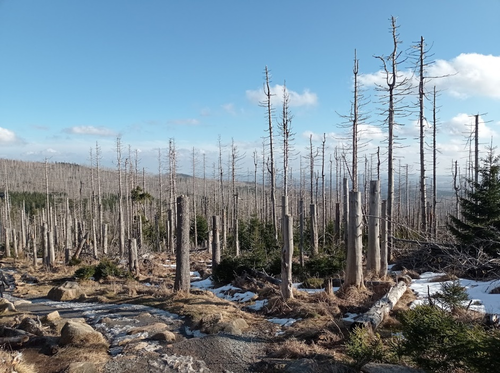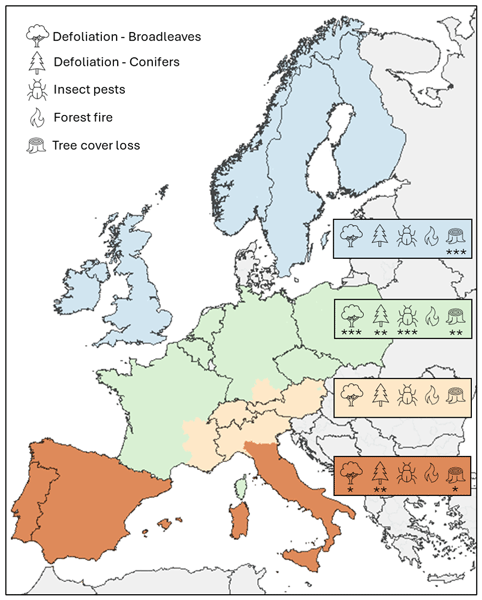Forest damage from climate extremes: Practical knowledge meets climate research
Figure 1: Area affected by forest calamities in the Harz region after the drought years (photo: F. Knutzen).
Figure 2: Differences in impacts and damage between the study period (2018-2022) and the reference period (2010-2014): crown defoliation, insect-damaged wood, burnt forest area, and tree cover loss. *Significance levels.
Figure 3: The brochure "Karlsruhe Urban Forest in a Changing Climate" provides clear information on climate-related changes and shows how the Karlsruhe Forestry Office is adapting the forest through concrete measures. Available online see References.
News from Jun 20, 2025
Drought, heat, and other climate extremes are increasingly challenging forest management in Germany. Since 2018 in particular, so-called "drought years" have become more frequent – with severe consequences for forest ecosystems, timber production, recreational use, biodiversity, and other societal demands on forests. The consequences of such years include massive vitality losses, pest infestations, and in some cases, large-scale forest damage. Scientific studies show that under unmitigated climate change (scenario RCP8.5), the frequency of biennial drought events could increase sevenfold by the end of the century (Hari et al., 2020).
As part of ClimXtreme, interviews and workshops with forestry professionals were conducted to systematically document their experiences with climate extremes and their impacts on forest management. These perspectives clearly show which events are perceived as particularly challenging in practice – and provide concrete indications of what kind of climate information is needed and used on the ground.
The term "drought year" is well established in forestry practice but has not yet been clearly defined. A joint definition from science and practice has not yet been established. Drought years such as 2018 to 2020 and 2022 are characterized by pronounced water deficits – especially during the growing season – leading to particularly severe ecological impacts. These are caused not only by a lack of precipitation but also by above-average evaporation, unfavorable precipitation distribution, site-specific soil conditions, and other local factors.
To better understand the actual effects of such years, data on drought and heat damage in forests across Europe from 2018 to 2022 were also analyzed (Knutzen et al., 2025). The results are clear: Central Europe experienced particularly strong losses in crown cover, significant insect infestations, and forest loss. In Southern Europe, forests proved more resilient, presumably due to their experience with recurring drought. Boreal forests in Northern Europe may have been less affected due to the use of site-appropriate tree species, while the Alpine region has been relatively spared so far, likely due to its elevation (Figure 1).
Insights from forestry practice paint a clear picture: drought and water scarcity are central challenges for future forest management. At the same time, different adaptation strategies are emerging depending on the forestry philosophy. Economically oriented stakeholders tend to focus more on silvicultural control, technical measures, and targeted tree species selection – sometimes including non-native species. Practitioners oriented toward nature conservation, on the other hand, emphasize biodiversity, native species, and close-to-nature development. There is broad agreement, however, that mixed stands, site-appropriate species, and structural diversity are key elements of climate-resilient forests.
A concrete example of the bridge between research, practice, and society is the new brochure “Karlsruhe Municipal Forest in Climate Change.” It is aimed at forest visitors and explains how the climate has changed since 1950, what effects are already visible, and what measures the Karlsruhe Forestry Office is taking in response. Familiar locations, illustrative graphics, and practical information help foster understanding of necessary adaptations – such as trail closures or changes in tree species.
Conclusion:
The exchange with forestry practitioners has provided ClimXtreme with important impulses to better understand drought years as a relevant issue in forestry. The perspectives from the interviews and workshops revealed which extreme events are perceived as critical and where existing scientific terms and indicators fall short. Forestry practice clearly shows: there is a need for applicable, practice-oriented definitions and analyses that take regional differences into account.
The impacts of drought years are highly site-specific. Even with similar weather conditions, damage can vary greatly – depending on soil conditions, tree species composition, and management approaches. Such differences are visible in practice and provide essential clues as to what kind of climate information is needed locally. Climate research can support this with regional scenarios, data series, and targeted drought indicators – provided they are tailored to specific forestry questions.
Long-term monitoring and continuous exchange between research and practice are essential. They enable the evaluation of adaptation measures and the flexible development of strategies. Furthermore, the Karlsruhe city forest brochure demonstrates that communication with the public is also crucial. Clear, practical formats help foster understanding of changes in the forest – and contribute to making necessary adaptations more transparent and socially acceptable.
By combining large-scale analysis, local experience, and transparent communication, a robust foundation for future-oriented forest adaptation can be created.
Referenzen:
Bülow, K., Bauer, S., Steuri, B., Groth, M., Knutzen, F., & Rechid, D. (2024). Stadtwald Karlsruhe im Klimawandel - Der Wald heute und in Zukunft. Zenodo. https://doi.org/10.5281/zenodo.11473737. https://www.climate-service-center.de/products_and_publications/fact_sheets/climate_action_sheets/wald/index.php.en
Hari, V., Rakovec, O., Markonis, Y., Hanel, M., & Kumar, R. (2020). Increased future occurrences of the exceptional 2018–2019 Central European drought under global warming. Scientific Reports, 10(1), 12207. https://doi.org/10.1038/s41598-020-68872-9
Knutzen, F., Averbeck, P., Haustein, K., Frör, O., & Groth, M. (2025a, in review). Perspectives of German forest practitioners on climate extremes: Consensus on impacts and conflicts in responses. Annals of Forest Research (in review).
Knutzen, F., Averbeck, P., Barrasso, C., Bouwer, L. M., Gardiner, B., Grünzweig, J. M., Hänel, S., Haustein, K., Johannessen, M. R., Kollet, S., Müller, M. M., Pietikäinen, J.-P., Pietras-Couffignal, K., Pinto, J. G., Rechid, D., Rousi, E., Russo, A., Suarez-Gutierrez, L., Veit, S., Wendler, J., Xoplaki, E., & Gliksman, D. (2025b). Impacts on and damage to European forests from the 2018–2022 heat and drought events. Natural Hazards and Earth System Sciences, 25, 77–117. https://doi.org/10.5194/nhess-25-77-2025
Autor:
Florian Knutzen





